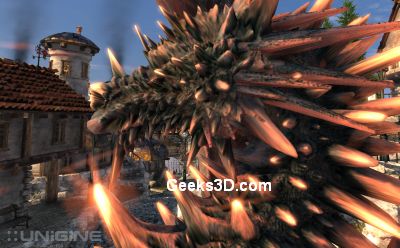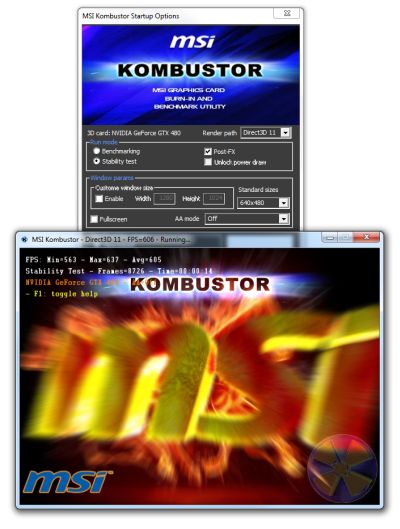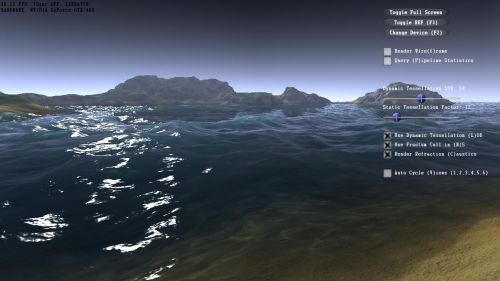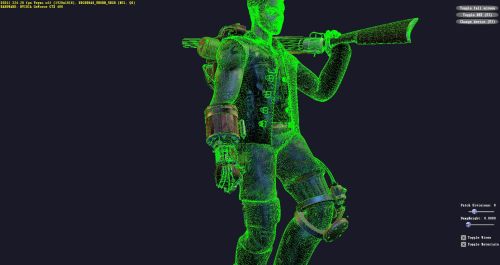SAPPHIRE Radeon HD 6870 Review Index
- 1 – Meet with SAPPHIRE’s Radeon HD 6870
- 2 – SAPPHIRE Radeon HD 6870 Features
- 3 – SAPPHIRE Radeon HD 6870 OpenGL performances
- 4 – SAPPHIRE Radeon HD 6870 Direct3D performances
- 5 – SAPPHIRE Radeon HD 6870 Gaming performances
- 6 – SAPPHIRE Radeon HD 6870 DirectCompute performances
- 7 – SAPPHIRE Radeon HD 6870 Power consumption and overclocking
- 8 – SAPPHIRE Radeon HD 6870: Misc Links and Reviews
4 – SAPPHIRE Radeon HD 6870 Direct3D performances
4.1 Unigine Heaven (DirectX 11)
OpenGL tests have been finished on Unigine Heaven, what a better transition than starting Direct3D tests with Unigine Heaven 2.1, this time using the Direct3D 11 render path.

Settings: 1920×1080 fullscreen, tessellation: normal, shaders: high, 4X MSAA, 16X anisotropic filtering.
| 47.6 FPS, Scores: 1200 – ASUS ENGTX580 |
| 39.4 FPS, Scores: 991 – EVGA GeForce GTX 480 |
| 26.8 FPS, Scores: 674 – ATI Radeon HD 5870 |
| 25.9 FPS, Scores: 653 – ASUS EAH6870 |
| 25.3 FPS, Scores: 637 – SAPPHIRE HD6870 |
| 25.6 FPS, Scores: 646 – MSI N460GTX Cyclone 768D5 |
| 16.6 FPS, Scores: 419 – MSI R5770 Hawk |
4.2 MSI Kombustor (Direct3D 9)
MSI Kombustor 1.1.3 has been used for the test. MSI Kombsutor is a Direct3D 9, 10, 11 and OpenGL 2 and 3 stress test and benchmark. I only tested the Direct3D 9 rendering.

Settings: 1920×1080 fullscreen, no AA, no postFX, 60sec, Unlock power draw CHECKED (the real benchmark mode!).
| 2378 (40FPS) – ASUS ENGTX580 *** OCP UNLOCKED *** |
| 1991 – EVGA GeForce GTX 480 |
| 1962 – ATI Radeon HD 5870 |
| 1833 – ASUS EAH6870 |
| 1816 – Sapphire Radeon HD 6870 |
| 1738 – ASUS ENGTX580 |
| 1595 – MSI GeForce GTX 470 |
| 1201 – MSI N460GTX Cyclone 768D5 OC |
| 943 – MSI R5770 Hawk (Cat 10.7) |
4.3 NVIDIA Island Demo: Tessellation (Direct3D 11)
NVIDIA Island demo is a D3D11 demo focused on, what a surprise, tessellation!

Settings: windowed (default size) and default params (tess factor: 12).
| FPS: 57 – ASUS ENGTX580 |
| FPS: 46 – EVGA GTX 480 |
| FPS: 25 – MSI N460GTX Cyclone 768D5 OC |
| FPS: 13 – ASUS EAH6870 |
| FPS: 13 – Sapphire Radeon HD 6870 |
| FPS: 11 – ATI Radeon HD 5870 |
| FPS: 10 – MSI R5770 Hawk |
4.4 DirectX SDK SubD11: Tessellation (Direct3D 11)
SubD11 is a Direct3D tessellation demo from the DirectX 11 SDK June 2010.

Settings: 1920×1080 windowed, tessellation: 8X
| FPS: 250 – ASUS ENGTX580 |
| FPS: 220 – EVGA GTX 480 |
| FPS: 135 – MSI N460GTX Cyclone 768D5 OC |
| FPS: 74 – ASUS EAH6870 |
| FPS: 73 – Sapphire Radeon HD 6870 |
| FPS: 60 – ATI Radeon HD 5870 |
| FPS: 53 – MSI R5770 Hawk |
Settings: 1920×1080 windowed, tessellation: 16X
| FPS: 118 – ASUS ENGTX580 |
| FPS: 102 – EVGA GTX 480 |
| FPS: 59 – MSI N460GTX Cyclone 768D5 OC |
| FPS: 19 – ASUS EAH6870 |
| FPS: 18 – Sapphire Radeon HD 6870 |
| FPS: 16 – ATI Radeon HD 5870 |
| FPS: 15 – MSI R5770 Hawk |
Settings: 1920×1080 windowed, tessellation: 24X
| FPS: 51 – ASUS ENGTX580 |
| FPS: 44 – EVGA GTX 480 |
| FPS: 27 – MSI N460GTX Cyclone 768D5 OC |
| FPS: 8 – ASUS EAH6870 |
| FPS: 8 – Sapphire Radeon HD 6870 |
| FPS: 8 – ATI Radeon HD 5870 |
| FPS: 7 – MSI R5770 Hawk |
Settings: 1920×1080 windowed, tessellation: 31X
| FPS: 30 – ASUS ENGTX580 |
| FPS: 26 – EVGA GTX 480 |
| FPS: 16 – MSI N460GTX Cyclone 768D5 OC |
| FPS: 5 – ASUS EAH6870 |
| FPS: 5 – Sapphire Radeon HD 6870 |
| FPS: 4 – ATI Radeon HD 5870 |
| FPS: 4 – MSI R5770 Hawk |
4.5 3DMark06 (Direct3D 9)
3DMark06 is one of the most used Direct3D 9 benchmark. It’s still interesting to have the scores for this benchmark.
Settings: default settings.
| Score: 22379 (SM2: 8212, SM3: 11585, CPU: 5805) – ASUS ENGTX580 |
| Score: 22162 (SM2: 8296, SM3: 11321, CPU: 5737) – EVGA GTX480 |
| Score: 21397 (SM2: 8377, SM3: 10419, CPU: 5683) – Radeon HD 5870 |
| Score: 21124 (SM2: 8337, SM3: 10146, CPU: 5689) – SAPPHIRE Radeon HD 6870 |
| Score: 20484 (SM2: 8199, SM3: 9470, CPU: 5806) – MSI N460GTX Cyclone |
Remark: this test is no longer adapted for modern GPUs. All cards have similar scores, meaning the benchmark is CPU-bound…
4.6 Aquamark 3 (Direct3D 9)
Aquamark 3 is a popular Direct3D 9 benchmark. Under Windows Vista or Seven, you have to install this patch. I posted the scores just for the fun because I don’t know if this tool is still representative of modern cards like GeForce GTX 500 / Radeon HD 6000…
Settings: default: 1024×768, fullscreen, 0XMSAA, 4X aniso.
| 163.7 FPS (GFX:28221, CPU:19477) – Radeon HD 5870 |
| 161.18 FPS (GFX:27513, CPU:19459) – Sapphire Radeon HD 6870 |
| 154.60 FPS (GFX:24018, CPU:21689) – MSI N460GTX Cyclone |
| 153.74 FPS (GFX:23931, CPU:21511) – GeForce GTX 480 |
Remark: like 3DMark06, this test is no longer adapted for modern GPUs. All cards have similar scores, meaning the benchmark is CPU-bound…
SAPPHIRE Radeon HD 6870 Review Index
- 1 – Meet with SAPPHIRE’s Radeon HD 6870
- 2 – SAPPHIRE Radeon HD 6870 Features
- 3 – SAPPHIRE Radeon HD 6870 OpenGL performances
- 4 – SAPPHIRE Radeon HD 6870 Direct3D performances
- 5 – SAPPHIRE Radeon HD 6870 Gaming performances
- 6 – SAPPHIRE Radeon HD 6870 DirectCompute performances
- 7 – SAPPHIRE Radeon HD 6870 Power consumption and overclocking
- 8 – SAPPHIRE Radeon HD 6870: Misc Links and Reviews
GTX 580 for Crysis, where is it?
GTX 580 Crysis score is for the next review. I’m testing a GTX 580 from EVGA…
guys seriously consider putting the index on the bottom of the site too.. using home key is a bit annoying and unfamiliar
@Lokadivu: done!
OK, will you then compare 6870 vs 580 ?
Radeons are fast enough in games, artificial bench demos it’s about the same as Sunspider bench who cares about that.
@iPristy: sure, all previous scores (HD 5870, HD 6870, GTX 4xx) will be in EVGA GTX 580 review.
Pingback: [Tested and Burned] EVGA GeForce GTX 580 SC Review - 3D Tech News, Pixel Hacking, Data Visualization and 3D Programming - Geeks3D.com
Pingback: [GPU Tool] ShaderToyMark 0.2.0 Demomakers’ Benchmark Available with Better SLI and CrossFire Support - 3D Tech News, Pixel Hacking, Data Visualization and 3D Programming - Geeks3D.com
Pingback: AMD Catalyst 10.12 WHQL (OpenGL 4.1, OpenCL 1.1) - 3D Tech News, Pixel Hacking, Data Visualization and 3D Programming - Geeks3D.com
Pingback: [Tested and Burned] SAPPHIRE Radeon HD 6970 2048MB Review - 3D Tech News, Pixel Hacking, Data Visualization and 3D Programming - Geeks3D.com
Pingback: [Tested] ASUS Radeon HD 6950 2GB GDDR5 Review - 3D Tech News, Pixel Hacking, Data Visualization and 3D Programming - Geeks3D.com
Pingback: [Tested and Burned] ASUS GeForce GTX 560 Ti DirectCU II TOP Review - 3D Tech News, Pixel Hacking, Data Visualization and 3D Programming - Geeks3D.com
these opengl tests do not at all reflect the performance of real opengl applications.
when using the latest fermi architecutre in opengl heavy 3d apps like blender, maya and so on the true weakness of these cards emerge.
it would be really great if you could add a test done in blender to the ones yu already did to see how the “real” opengl performance is.